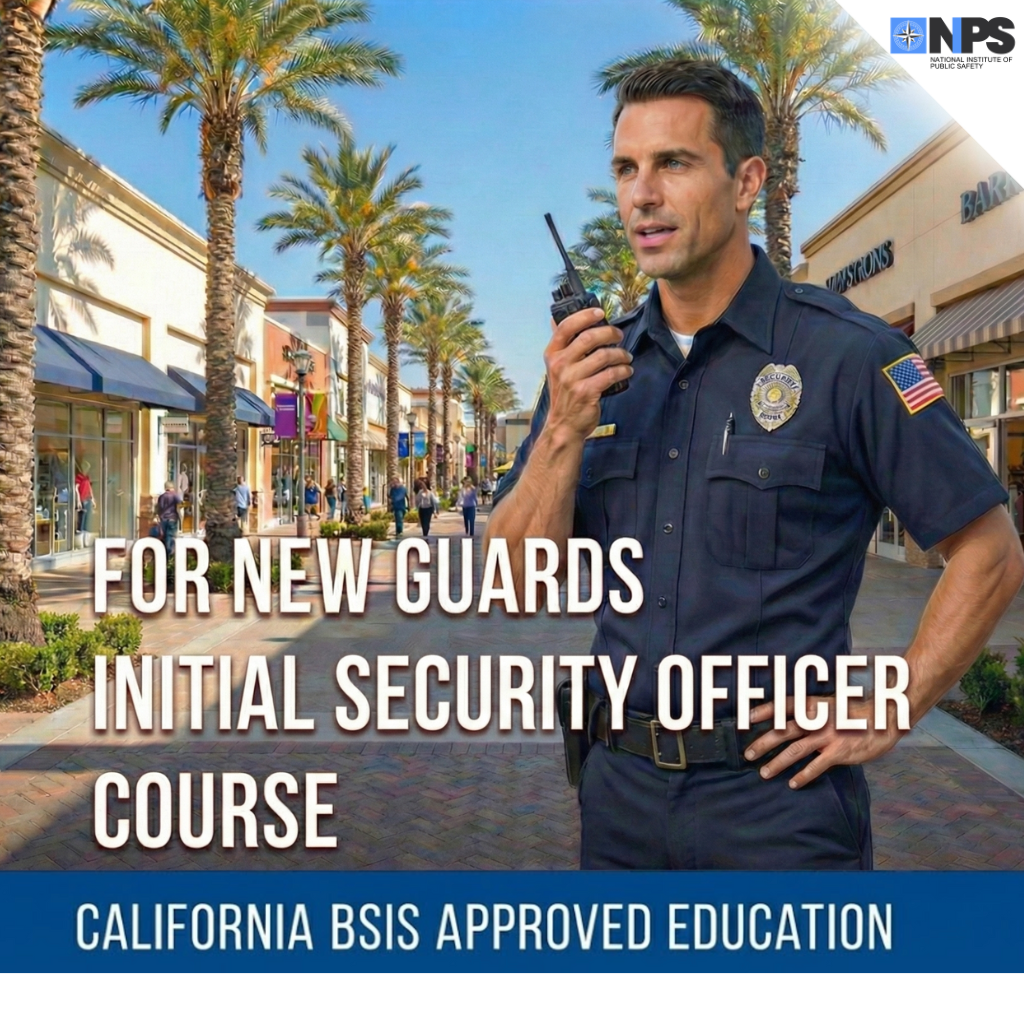(For New Guards) Initial Security Officer Course (California)

About Course
Instructor: National Institute of Public Safety (National IPS)
Level: Beginner | Course Type: Hybrid | Duration: 4 Hours Online + 4 Hours In Person (In-Person Sessions Offered in Los Angeles County, Santa Clarita)
Certificate of Completion: Awarded Upon Completion of Both Parts
BSIS Licensed Training Provider ID#: ATG-2976
This Course Fulfills the 8-Hour Powers to Arrest & Appropriate Use of Force Training – Required to Obtain a California Guard Card
Description: This 8-hour BSIS-approved Powers to Arrest and Appropriate Use of Force course is required for all new security guards applying for a California Guard Card. Completion of this training and obtaining a guard card is mandatory before you can legally work as a security guard in California.
Important: Working as a security guard without a valid California Guard Card is illegal.
🏷️ NOW ONLY $99! (Limited Time Offer!)
BSIS California Guard Card Initial Training Requirements
Per the BSIS Security Guard Fact Sheet: “The Power to Arrest training must be completed prior to the issuance of a Security Guard Registration (BPC Sections 7583.6 and 7583.8).”
This course fulfills the mandatory Power to Arrest training required before obtaining a California Security Guard Registration (Guard Card).
After completing this 8-Hour Power to Arrest & Appropriate Use of Force course, you will be eligible to apply for your California BSIS Guard Card.
View BSIS Security Guard Registration Fact Sheet Here
 Start Training Now, Get Your California Guard Card – Pay Later!
Start Training Now, Get Your California Guard Card – Pay Later!
Your future in security starts today. With National IPS California Guard Card Training Online, you can train now, pay later, with flexible monthly payment plans launch your career faster than ever.
Select “Train Now, Pay Later Partner AFFIRM, KLARNA, or AFTERPAY” at checkout.
Start your training immediately, pay later, and earn your California Guard Card!
Your future in security begins today—enroll now and take control of your career!
⚠️ WARNING: Beware of Ultra-Cheap “3-Hour 100% Online $13.99–$19.99 Powers to Arrest Guard Card pre-licensing” courses
These Cheap Courses are bait-and-switch scams. BSIS actually requires at least 8 hours of training with 50% in-person instruction, and it has received numerous complaints about these fake courses; protect your future and learn more in our blog Here and view the Official Bureau of Security and Investigative Services (BSIS) Warning Here.
Course Description
This comprehensive Initial Security Officer Training—Power To Arrest and Appropriate Use of Force—is officially recognized by the California Bureau of Security and Investigative Services (BSIS) and fulfills the mandatory training requirement for security guard registration in California.
Designed for both aspiring and current security professionals, the course provides critical legal and procedural training on the authority and limitations that security guards must operate within. Unlike peace officers, security personnel must follow a specific legal framework. This course ensures you meet the mandatory training standards set by BSIS.
To support your learning, a downloadable BSIS Power To Arrest and Appropriate Use of Force Training Manual is provided and required for this course. The manual serves as a study guide and reference to help you follow along with the lessons, reinforce key concepts, and prepare for real-world application.
What You’ll Learn
-
The legal powers granted to California security guards under BSIS guidelines
-
How to lawfully observe, approach, detain, and arrest individuals
-
The difference between the authority of peace officers and security guards
-
When and how to use reasonable force—and how to stay within legal limits
-
How to protect yourself and your employer from criminal and civil liability
-
Proper techniques for report writing, including separating facts from assumptions
-
The importance of professional conduct and effective communication
-
How to collaborate appropriately with local law enforcement
Why This Course Matters
Security guards are often the first line of response in emergencies and suspicious situations. Understanding the law—and your role within it—is not just important, it’s required. This course prepares you to perform your duties professionally and confidently, helping protect yourself, your employer, and the public.
Course Requirements
-
No prior experience required
- Must be at least 18 Years of Age.
-
Completion of both parts:
-
Part 1: Online Portions of The Powers to Arrest & Appropriate Use of Force Course.
-
Part 2: In-Person Portions of The Appropriate Use of Force Training (BSIS Requirement)
-
-
Access to the National IPS scheduling platform provided for in-person registration
💡Important Note:
Per BSIS regulations, this course can no longer be completed entirely online. At least 50% of the Powers to Arrest and Appropriate Use of Force training must be conducted in person through traditional classroom instruction.
View Link To The BSIS PTA & FQ Training Changes Notification (November 14, 2024) Here
Who This Course Is For
-
Individuals seeking to become licensed security guards in California
-
Employers looking to certify new security staff
-
Anyone interested in understanding the legal rights and limitations of private security professionals
Next Steps After Training
Once you complete both parts of the training (4 hours online + 4 hours in person), Here’s what comes next to become BSIS Security Officer Licensed:
- Submit Your Guard Card Application
Apply online through the BSIS BreEZe portal or by mail using the appropriate form.
Online BSIS Security Guard Application Link BreEZe Portal Link:
📎:https://www.breeze.ca.gov/datamart/loginCADCA.do
Paper BSIS Security Guard Application Form Link:
📎: https://www.bsis.ca.gov/forms_pubs/gappnew.pdf
-
Complete Live Scan Fingerprinting
Visit a BSIS-approved Live Scan location to submit your fingerprints for a background check.
Paper BSIS Live Scan Form Link:
📎: https://www.bsis.ca.gov/forms_pubs/livescan/guard.pdf
💡 Important Note: Live Scan and BSIS application fees are not included in your course purchase and must be paid separately.
💡BSIS Certificate of Completion Note:
All registered security guards are required to maintain their certificate of completion of the required training until the registration expires or has been canceled (BPC 7583.6). Employers are required to maintain records for the duration of the registrant’s employment.
Need help with this process? We’ll provide detailed instructions during training to guide you every step of the way.
Our Accreditation & Licensing
This course is officially licensed and approved by the California Bureau of Security & Investigative Services (BSIS).
The National Institute of Public Safety (National IPS) is an authorized BSIS training provider under Approval Number ATG-2976. This ensures that all training you receive through our program meets the requirements set by the State of California for security guard certification.
By enrolling with us, you can be confident that your training is:
-
Compliant with BSIS regulations
-
Recognized for Guard Card certification in California
-
Delivered by a licensed and approved training provider
View our BSIS Licensed Guard Card Training Provider Info Here

 Live Interaction with Your Instructor
Live Interaction with Your Instructor
Every National Institute of Public Safety course includes live interaction with your course instructor in real time through our built-in chat feature. You can ask questions, clarify lessons, and receive direct feedback as you progress through the training.
For a more personal learning experience, optional Zoom sessions with your course instructor 
At National IPS, our mission is to ensure every student leaves confident, prepared, and field-ready — not just trained, but truly equipped for professional success.
🛡️ All Security Officer Courses Are Protected by Our “Worry-Free Guarantee”
Train with confidence at National IPS with our Worry-Free Guarantee — all courses are BSIS-approved and meet California’s legal requirements. If you are not 100% satisfied with your course within 72 hours of purchase (and haven’t completed all the lessons), you get a full refund, no questions asked. Terms apply.
✅ Enroll now and take the first step toward becoming a fully compliant, confident, and capable California security professional.
Course Disclaimer:
Completion of this training course shall not, standing alone, constitute licensure or registration as a security guard under California law. Such licensure remains exclusively within the purview of the California Bureau of Security and Investigative Services (“BSIS”), contingent upon full compliance with all statutory eligibility requirements, submission of a proper application, successful Live Scan fingerprinting, and clearance of requisite background investigations. The National Institute of Public Safety’s sole role is to provide training; it disclaims any warranties or guarantees, express or implied, concerning any individual’s attainment of licensure or certification.
Course Content
Initial Security Officer Course Overview
-
1.1 Course Overview
00:00 -
Course Overview Assessment
Module 1: The Roles and Responsibilities of Security Personnel
Module 2: Encounters and Arrest
Module 3: Legal Framework and Responsibilities
Module 4: Cultural Competency, Bias, and Interaction Skills
Conclusion and Next Steps
Student Ratings & Reviews
5.0
How to Enroll in the In-Person Appropriate Use of Force Session
This session is part of the Initial Security Officer Certification Course (California): Powers to Arrest & Appropriate Use of Force and is required by the BSIS to complete your New Guard Certification.
✅ Step 1: Click The Blue “Schedule a Time with Me” Button
-
Scroll Up or to the bottom of the page and click the blue “Schedule a Time with Me” button.
-
You will be redirected to our Calendly scheduling page.
✅ Step 2: Select Your Preferred Date and Time
-
Review the available dates and time slots for the In-Person Appropriate Use of Force Session.
-
Click on the time that works best for you.
✅ Step 3: Confirm Your Booking
-
Fill out your name, email address, and any additional information requested.
-
Click Confirm.
-
You will receive an email confirmation with all the details and location for your in-person session.
✅ Step 4: Bring Your Online Certificate
-
You must show your Certificate of Completion for the online Powers to Arrest Portion to your in-person instructor at the start of the session.
-
Digital copy (on your phone) or printed version is acceptable.
What Will Be Taught In-Person?
This session focuses on real-world application and scenario-based training to prepare you for the field. Key training topics include:
-
The Use of Objectively Reasonable Force
-
Use of Force Review and Analysis
-
De-Escalation and Interpersonal Communication
-
Scenario-Based Training
-
Active Shooter Situations
- Other Topics Required by BSIS for In-Person Training
What You Will Learn Online (Course Overview)
Before attending the in-person session, you will complete the online portion of the course, which covers:
-
BSIS Powers to Arrest Training
Next Steps: Apply for Your California Guard Card
After you complete both:
-
The Online Powers to Arrest & Appropriate Use of Force Training (and present proof at your in-person session), and
-
The In-Person Appropriate Use of Force Session,
You will receive your Official Certificate of Completion form National IPS for the Powers to Arrest & Appropriate Use of Force Course.
You can then:
-
Submit your application to BSIS for your California Guard Card.
-
Receive your Guard Card from the BSIS and start working as a licensed security officer in California (When Approved).
Click Here to Get Started:






